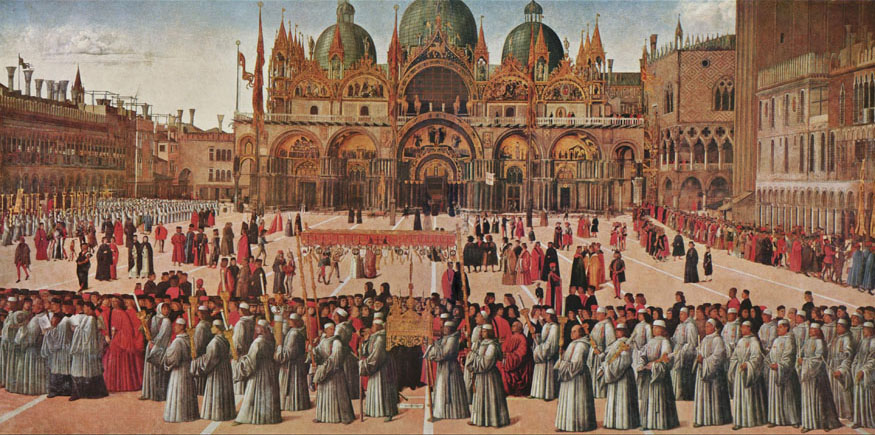Fr : version française / En: english version
mheu, Historical Museum of the Urban Environment
Procession of the True Cross in Piazza San Marco, Venice
Gentile Bellini

1496
367cm × 745cm
oil on canvas
Galleria dell'academia, Venice, Italy
© Wikimedia commons
View this work in the exhibition The Street
The work
Gentile's Procession gives us a fairly accurate picture of what Piazza San Marco looked like in the late 15th century, before the Byzantine buildings were replaced in the early 16th century by the Procuratie Vecchie and their 50 arcades, and before it was remodeled by Napoleon, who introduced the Ala Napoleonica.
The background clearly shows the front of Saint Mark's Basilica—then a lot more colorful than it is today—with its green domes.
Behind the procession, in the trapezoid-shaped square, the artist depicts men absorbed in natural conversation. Elsewhere, a face looks out from the picture from below one of the daises. According to Vasari, that face belongs to Giovanni, Gentile's half-brother.
The artist
The Bellini family had its fair share of painters: the father, Jacopo, his eldest son, Gentile, and Gentile's younger half-brother, Giovanni. Gentile was born in Venice around the year 1428, perhaps a little earlier. He was a realist artist who lacked his brother's sensibility and focused on genre paintings such as processions and scenes of daily life.
His first acclaimed work dates back to 1465. Gentile became the official portrait artist for the Doges and was sent to Constantinople in 1479 to record the peace treaty signed between the Republic of Venice and Turkey. He stayed on for a year and painted the portrait of Sultan Mehmed II. Sadly, the fire that destroyed the Doges' Palace in 1577 took with it all of the great historical paintings on the peace pact between Alexander III and Emperor Barbarossa that he painted with Giovanni. Only three works from the Scuola Grande di San Giovanni Evangelista remain, in which, alongside the main scene showing the miracles attributed to the relic of the Holy Cross, Gentile depicts scenes of daily life in Venice.
The artist's ability to clearly portray real figures in these genre paintings brought him much acclaim. Gentile Bellini died in Venice in 1507, his last work unfinished, The Preaching of Saint Mark in Alexandria.